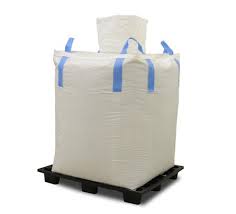How to Store Conical Bulk Bags for Maximum Freshness

HDPE (High-Density Polyethylene) is a strong and durable thermoplastic material. Its strength is derived from its molecular structure, which consists of long chains of ethylene monomers. The high density of these chains results in a material with exceptional strength and impact resistance.
Here are some key characteristics that highlight the strength of HDPE:
Tensile Strength: HDPE has high tensile strength, meaning it can resist pulling forces without easily breaking or deforming. The tensile strength of HDPE can range from 20 to 37 MPa (megapascals).
Flexural Strength: HDPE exhibits good flexural strength, allowing it to withstand bending or flexing without permanent deformation. The flexural strength of HDPE can be around 12 to 50 MPa.
Impact Resistance: HDPE is known for its excellent impact resistance, making it suitable for applications where it may experience sudden impacts or loads. It can withstand heavy impacts without shattering or breaking.
Chemical Resistance: HDPE is highly resistant to a wide range of chemicals, including acids, bases, and solvents. This property contributes to its durability in various industrial and chemical applications.
Weather Resistance: HDPE is UV resistant and can withstand exposure to sunlight and weathering without significant degradation. This makes it suitable for outdoor applications.
Water Resistance: HDPE is impermeable to water, making it an ideal material for applications where moisture resistance is essential, such as water pipes or containers.
Abrasion Resistance: HDPE has good abrasion resistance, making it suitable for applications where the material comes into contact with abrasive substances.
Temperature Resistance: HDPE can withstand a wide range of temperatures, from as low as -50°C (-58°F) to as high as 80°C (176°F) for short periods, depending on the grade of HDPE used.
It’s important to note that the strength and properties of HDPE can vary depending on the grade and manufacturing process. HDPE is widely used in various industries, including packaging, piping, construction, automotive, and more, due to its exceptional strength and versatility.
Storing conical bulk bags properly is essential to maintain the freshness and quality of the contents. Conical bulk bags are often used for storing and transporting bulk materials like grains, seeds, and powders. Here are some tips on how to store them for maximum freshness:
Choose a Clean and Dry Storage Area: Select a clean and dry storage location that is free from dust, dirt, and potential contaminants. A covered storage area or warehouse is ideal to protect the bulk bags from exposure to the elements.
Avoid Sunlight and Heat Exposure: Direct sunlight and excessive heat can lead to temperature fluctuations and spoil the contents inside the bulk bags. Store them away from windows or areas with high heat sources.
Maintain Consistent Temperature: Fluctuating temperatures can cause condensation inside the bags, which may lead to spoilage or clumping of the contents. Aim to maintain a stable and moderate temperature within the storage area.
Use Pallets or Racks: Keep the conical bulk bags on pallets or racks to elevate them off the ground. This helps to prevent moisture from the floor from affecting the bags and allows air circulation around the bags.
Inspect Bags for Damage: Before storing, carefully inspect the bulk bags for any tears, punctures, or damage that may compromise the integrity of the contents. Damaged bags should be repaired or replaced to avoid contamination or spillage.
Seal Open Bags Properly: If you open a bulk bag and don’t use all of its contents, ensure the remaining portion is well-sealed before storage. For example, you can use bag clips, zip ties, or heat sealing equipment to close the bag securely.
Rotate Stock and FIFO: Implement a “first in, first out” (FIFO) system to ensure that older stock is used first. This practice helps prevent spoilage or degradation of the contents due to prolonged storage.
Use Desiccants or Moisture Absorbents: In environments with high humidity, consider using desiccants or moisture-absorbing packets inside the bulk bags to protect the contents from moisture damage.
Avoid Pests: Take measures to prevent pests and insects from entering the storage area. Keep the area clean, and consider using pest-control methods if necessary.
Follow Manufacturer Guidelines: If the bulk bags come with specific storage instructions from the manufacturer, be sure to follow them accordingly to maintain the freshness and quality of the contents.
By following these storage practices, you can ensure that conical bulk bags keep their contents fresh and in optimal condition for as long as possible.
--------------------------------
Guestbeat.com Notice!
Audience discretion is needed, Read TOS.
Submit Guest Post / Read Latest / Category List
App & Rate-Us / Subscribe Daily Newsletter (FREE)



